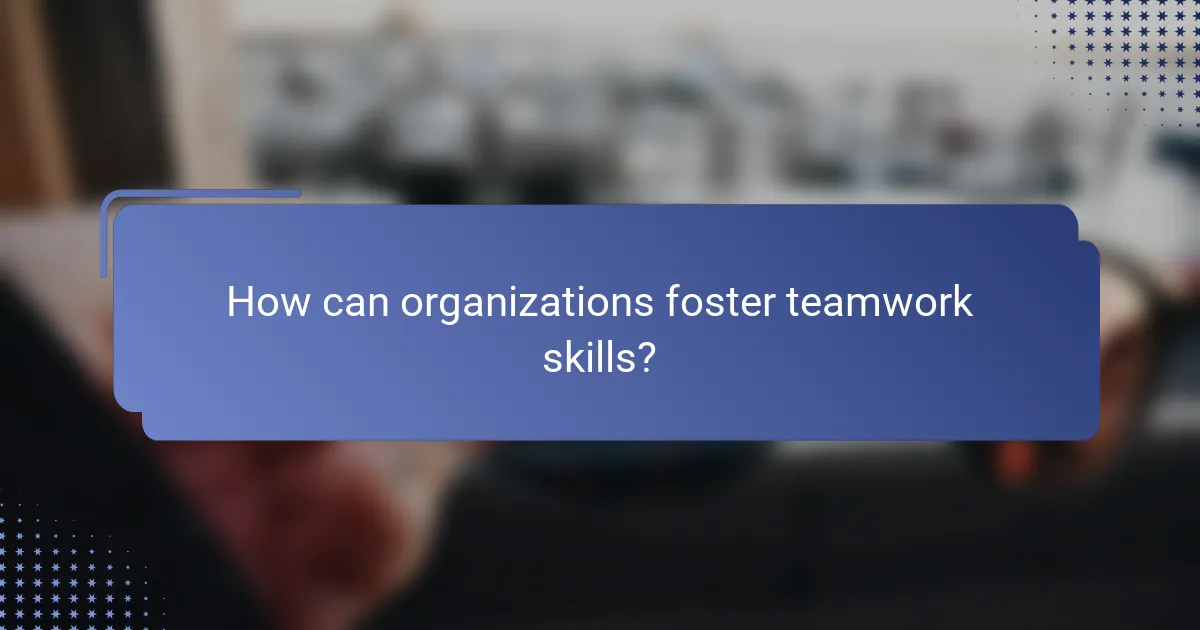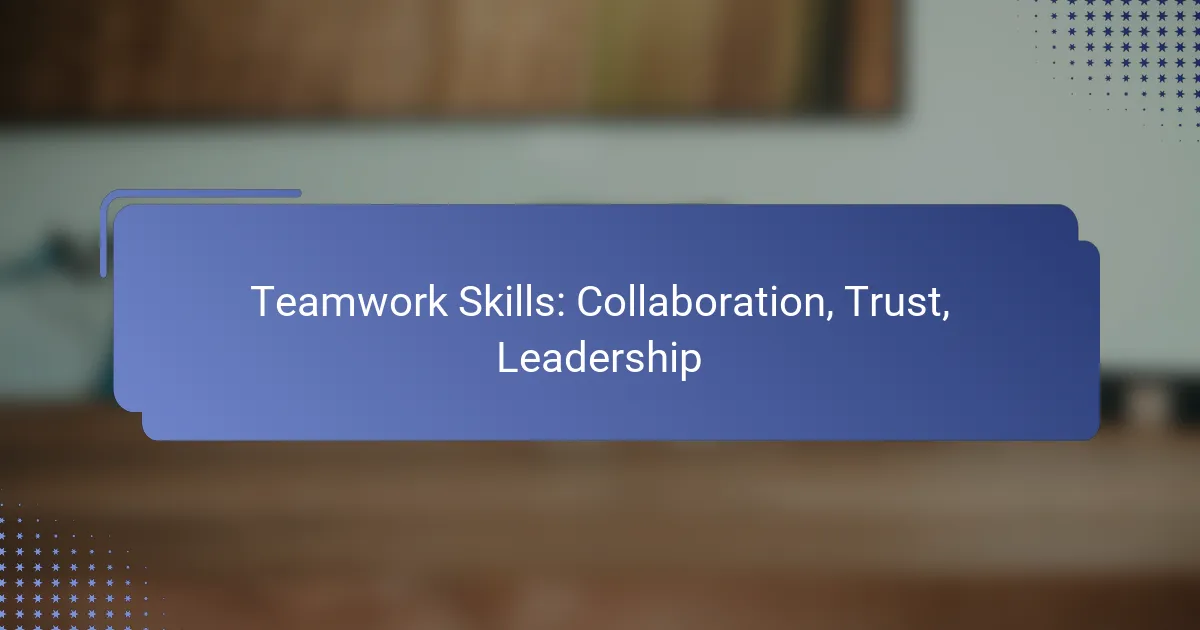Teamwork skills are crucial for fostering collaboration, trust, and effective leadership within a group. By creating a cooperative environment, team members can share ideas and resources more freely, leading to improved decision-making and innovation. Trust among team members enhances communication and collaboration, while strong leadership guides the team towards achieving common goals.

How can teamwork skills improve collaboration in teams?
Teamwork skills significantly enhance collaboration by fostering a cooperative environment where team members can effectively share ideas and resources. Improved collaboration leads to better decision-making and innovation, ultimately benefiting the team’s overall performance.
Enhanced communication
Effective communication is crucial for successful teamwork. When team members communicate openly, they can share insights, clarify misunderstandings, and provide feedback, which helps align goals and expectations.
To enhance communication, teams can implement regular check-ins or use collaborative tools like Slack or Microsoft Teams. These platforms facilitate real-time discussions and keep everyone informed about project developments.
Increased productivity
Teamwork skills can lead to increased productivity by streamlining processes and minimizing redundancies. When team members collaborate effectively, they can delegate tasks based on individual strengths, allowing for more efficient use of time and resources.
For example, using project management software can help teams track progress and deadlines, ensuring that everyone stays on the same page and contributes to meeting objectives promptly.
Better conflict resolution
Strong teamwork skills enable teams to address conflicts constructively. When team members trust each other and communicate openly, they are more likely to resolve disagreements amicably rather than letting them escalate.
Establishing ground rules for conflict resolution, such as active listening and respectful dialogue, can help teams navigate disputes effectively. This approach fosters a culture of collaboration where differing opinions are valued.
Stronger relationships
Building strong relationships among team members is essential for effective collaboration. Trust and mutual respect create a supportive environment where individuals feel comfortable sharing ideas and taking risks.
Team-building activities, both in-person and virtual, can strengthen these relationships. Regular social interactions help team members connect on a personal level, which can enhance their collaboration in professional settings.

What role does trust play in effective teamwork?
Trust is essential for effective teamwork as it creates a safe environment where team members feel valued and respected. When trust is present, individuals are more likely to communicate openly, share ideas, and collaborate towards common goals.
Foundation for open dialogue
Trust establishes a foundation for open dialogue among team members. When individuals trust each other, they are more willing to express their thoughts, concerns, and feedback without fear of judgment. This open communication leads to better problem-solving and innovation.
To foster open dialogue, encourage regular check-ins and create spaces for sharing ideas. Utilize tools like anonymous surveys or suggestion boxes to help team members voice their opinions comfortably.
Encourages risk-taking
Trust encourages team members to take risks, which is vital for growth and innovation. When individuals feel secure in their environment, they are more likely to propose new ideas or challenge the status quo, knowing that their contributions will be valued.
To promote risk-taking, celebrate both successes and failures as learning opportunities. Establish a culture where experimentation is encouraged, and provide support for those who step outside their comfort zones.
Fosters accountability
Trust fosters accountability within a team by creating a sense of responsibility among members. When team members trust each other, they are more likely to hold themselves and one another accountable for their actions and commitments.
To enhance accountability, set clear expectations and goals for the team. Regularly review progress and provide constructive feedback to ensure everyone is aligned and responsible for their roles.

How can leadership enhance teamwork skills?
Leadership can significantly enhance teamwork skills by providing direction, fostering trust, and encouraging collaboration among team members. Effective leaders create an environment where individuals feel valued and motivated to contribute their best efforts toward common goals.
Guiding team vision
A clear team vision helps align individual efforts with the overall objectives of the group. Leaders should articulate this vision in a way that resonates with team members, ensuring everyone understands their role in achieving it. Regularly revisiting the vision can keep the team focused and motivated.
To effectively guide the team vision, leaders can use visual aids, such as charts or infographics, to illustrate goals and progress. This not only clarifies expectations but also fosters a sense of ownership among team members.
Empowering team members
Empowerment involves giving team members the authority and responsibility to make decisions related to their work. Leaders can enhance teamwork skills by encouraging autonomy and trusting team members to take initiative. This approach can lead to increased engagement and innovation.
To empower team members, leaders should provide the necessary resources and support while allowing individuals to explore solutions independently. Regular feedback and recognition can further reinforce their confidence and commitment to the team.
Facilitating collaboration
Collaboration is essential for effective teamwork, and leaders play a crucial role in facilitating this process. By creating opportunities for team members to work together, leaders can enhance communication and build stronger relationships within the group. Tools like collaborative software can streamline this interaction.
Leaders should encourage open dialogue and provide structured opportunities for brainstorming and problem-solving sessions. Establishing clear roles and responsibilities during collaborative efforts can also help minimize confusion and ensure that everyone contributes effectively.

What are the key attributes of successful teamwork?
Successful teamwork hinges on several key attributes that foster collaboration and drive results. These include clear goals, defined roles, and mutual respect among team members, all of which contribute to a cohesive and productive work environment.
Clear goals
Clear goals provide direction and purpose for the team. When everyone understands the objectives, it becomes easier to align efforts and measure progress. Goals should be specific, measurable, achievable, relevant, and time-bound (SMART) to ensure clarity.
For example, instead of a vague goal like “improve sales,” a clear goal would be “increase sales by 15% over the next quarter.” This specificity helps team members focus their efforts and track their contributions effectively.
Defined roles
Defined roles clarify each team member’s responsibilities, reducing confusion and overlap. When everyone knows their specific tasks, it enhances accountability and efficiency. Roles should be based on individual strengths and expertise to maximize team performance.
A practical approach is to create a RACI matrix (Responsible, Accountable, Consulted, Informed) to outline who does what in a project. This tool helps ensure that all aspects of the project are covered and that team members understand their contributions.
Mutual respect
Mutual respect is essential for fostering a positive team culture. When team members value each other’s opinions and contributions, it encourages open communication and collaboration. Respect can be cultivated through active listening, constructive feedback, and recognizing achievements.
To promote mutual respect, teams should establish norms for communication and conflict resolution. Regular team-building activities can also strengthen relationships and enhance trust among members, leading to a more harmonious work environment.

How can organizations foster teamwork skills?
Organizations can foster teamwork skills by implementing structured approaches that enhance collaboration, trust, and leadership among team members. This includes providing training programs, engaging in team-building activities, and establishing effective feedback mechanisms.
Training programs
Training programs are essential for developing teamwork skills. These programs should focus on communication techniques, conflict resolution, and collaborative problem-solving. Regular workshops or seminars can help employees understand their roles within a team and improve their interpersonal skills.
Consider incorporating role-playing exercises and simulations that mimic real workplace scenarios. This hands-on approach allows team members to practice skills in a safe environment, leading to better retention and application of teamwork principles.
Team-building activities
Team-building activities are crucial for strengthening relationships and trust among team members. These activities can range from simple icebreakers to more complex challenges that require collaboration, such as escape rooms or outdoor retreats. The key is to create opportunities for employees to interact outside of their usual work tasks.
When planning team-building events, ensure they are inclusive and cater to diverse interests. Activities should promote engagement and allow team members to showcase their strengths while learning to rely on one another.
Feedback mechanisms
Establishing effective feedback mechanisms is vital for continuous improvement in teamwork skills. Regular check-ins, peer reviews, and anonymous surveys can provide valuable insights into team dynamics and individual contributions. This feedback should be constructive and aimed at fostering a culture of open communication.
Encourage a growth mindset by framing feedback as an opportunity for development rather than criticism. This approach helps team members feel safe to express their thoughts and concerns, ultimately leading to stronger collaboration and trust within the team.

What frameworks can guide teamwork development?
Frameworks for teamwork development provide structured approaches to enhance collaboration, trust, and leadership among team members. These frameworks help teams identify their strengths and weaknesses, establish clear roles, and improve communication.
Collaboration frameworks
Collaboration frameworks focus on creating environments where team members can work together effectively. Techniques such as Agile and Scrum emphasize iterative progress and regular feedback, allowing teams to adapt quickly to changes. Tools like shared digital workspaces can facilitate real-time collaboration, ensuring everyone stays aligned on project goals.
When implementing a collaboration framework, consider the specific needs of your team. For instance, if your team is remote, investing in video conferencing and project management tools can enhance interaction. Establishing regular check-ins can also help maintain momentum and address any challenges promptly.
Trust-building strategies
Trust is foundational for effective teamwork. Strategies to build trust include open communication, transparency in decision-making, and recognizing individual contributions. Encouraging team members to share their ideas and concerns fosters an environment where everyone feels valued.
To strengthen trust, consider team-building activities that promote personal connections. Simple exercises like sharing personal stories or participating in group challenges can enhance relationships. Regular feedback sessions can also help clarify expectations and reinforce trust among team members.
Leadership models
Leadership models guide how team leaders can inspire and motivate their teams. Approaches like transformational leadership focus on encouraging team members to exceed their own interests for the sake of the group, fostering a shared vision. Servant leadership emphasizes the leader’s role in supporting team members and prioritizing their needs.
When applying a leadership model, assess the dynamics of your team. For example, in a diverse team, a participative leadership style may be effective, allowing for input from all members. Regularly revisiting the leadership approach can help adapt to changing team needs and enhance overall performance.



